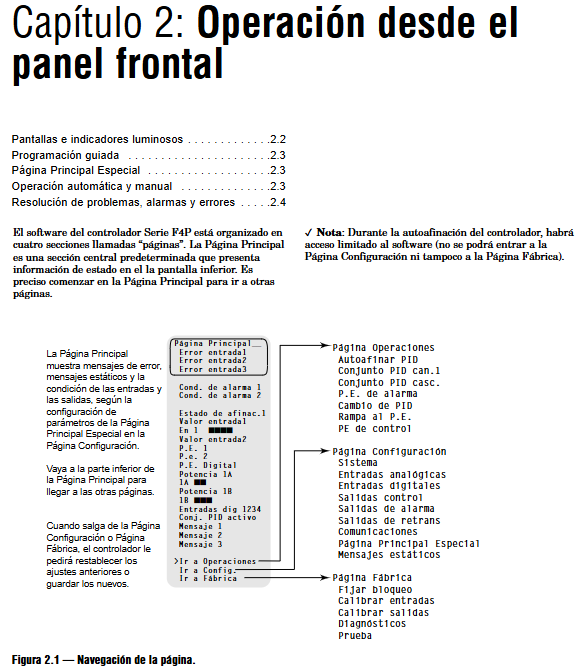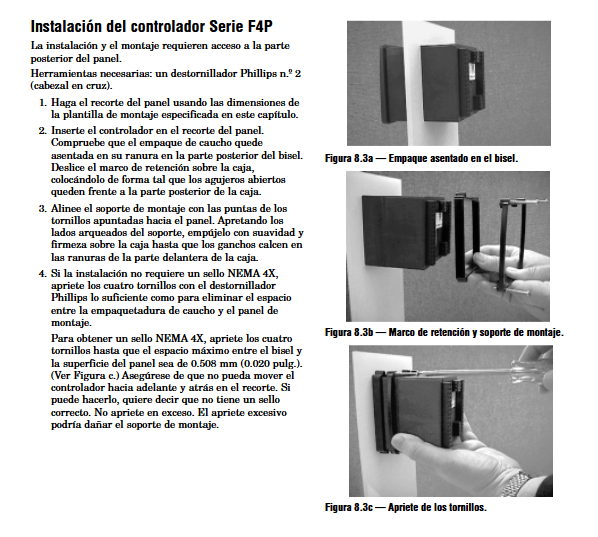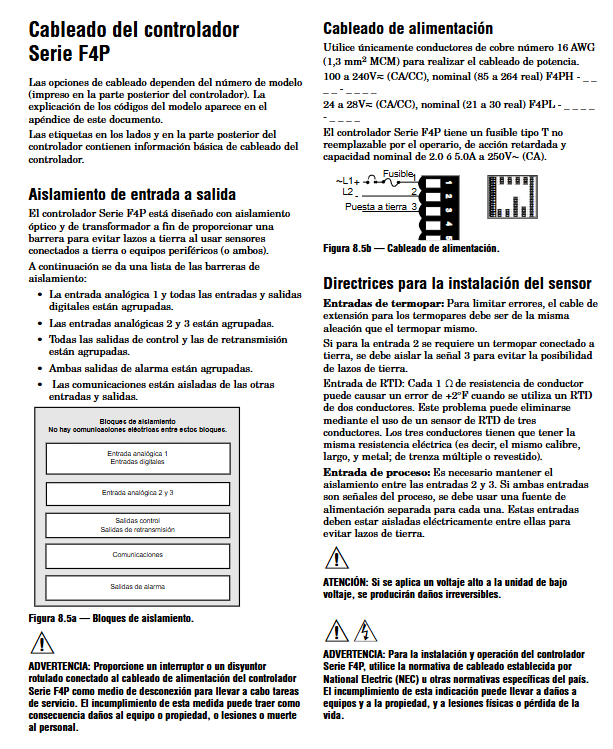

K-WANG


Watlow Series F4P Series 1/4 DIN (96 × 96mm) Temperature/Process Controller
Watlow Series F4P Series 1/4 DIN (96 × 96mm) Temperature/Process Controller
Product basic information and positioning
1. Core positioning
Specially designed for industrial process control, it can be installed independently or integrated, providing measurement and control of temperature, pressure and other parameters, supporting single/multi loop linkage, adapting to bidirectional control scenarios such as heating and cooling, and possessing both basic control and advanced extended functions (such as cascade control and proportional control).
2. Basic specifications
Appearance and Installation: 96 × 96mm panel installation, thickness 97mm, with reserved panel openings of 92-93mm, vertical installation, supporting NEMA 4X/IP65 protection level (must be properly tightened and sealed).
Power supply requirements: 100-240V AC (50/60Hz) or 24-28V AC/DC, maximum power consumption of 39VA, Class 2/SELV certified power supply, supporting Semi F47-0200 voltage drop standard.
Environmental adaptability: working temperature 0-65 ° C, storage temperature -40-70 ° C, 0-90% RH (non condensing), compliant with UL, CE, EN 61010 and other safety certifications, some models support Class 1 Div. 2 hazardous areas.
Warranty and Support: 3-year warranty (non misuse scenario), technical support can be obtained through phone or email, and returns need to apply for an RMA number in advance.

Core functions and technical features
1. Input/output capability
(1) Input type and specifications
Input type, quantity, key parameters, applicable scenarios
Universal analog input 1 channel (advanced version 2-3 channels) supports thermocouple (11 types including J/K/T), RTD (2-3 wire system, 100 Ω platinum), process signal (0-10V, 4-20mA, etc.), input impedance: voltage 20k Ω, current 100 Ω, temperature, pressure and other parameter acquisition
Four digital inputs support dry contact/DC voltage input (low state<2V, high state>3V), with a response frequency of 10Hz for external triggering and status feedback (such as door switches and limit signals)
(2) Output type and specifications
Output Type Quantity Key Parameters Applicable Scenarios
Control output 2-channel (1A/1B) optional relays (2A/250V AC), SSR (0.5A/24-253V AC), open collector (42V DC/0.5A), process output (4-20mA/0-10V) to drive heaters, refrigeration equipment, valves
Alarm output 2-channel mechanical relay (Form C, 2A/250V AC), supporting normally open/normally closed configuration fault alarm and emergency stop linkage
Resend output (optional) 1-2 channels of 4-20mA (maximum 800 Ω) or 0-10V (minimum 1k Ω) with an accuracy of ± 30 μ A/± 15mV signal to the recorder PLC
2. Control and calculation functions
(1) Basic control mode
Switch control: The device can be started and stopped by setting a threshold and hysteresis, and the hysteresis can be adjusted (1-9999 units) to avoid frequent switching.
PID control: supports proportional (P), proportional integral (PI), and proportional integral derivative (PID) regulation, stores 5 sets of PID parameters, and adapts to different operating conditions for switching.
Automatic tuning: Through 4 oscillation tests crossing the set point, the optimal PID parameters are automatically calculated, supporting local (internal loop) or global tuning.
Multi PID switching: can trigger 5 sets of PID parameter switching based on set points or process values, suitable for a wide range of operating conditions (such as different characteristics in high and low temperature ranges).
(2) Advanced control functions
Cascade Control (Advanced Version): Dual loop linkage, with the output of the external loop (such as process temperature) serving as the set point for the internal loop (such as heat source temperature), reducing overshoot and hysteresis.
Proportional/Differential Control (Advanced Version): Proportional control supports proportional operation between process values and reference values, while differential control adjusts output based on parameter change rate.
Valve positioning control (advanced version): Feedback valve position through potentiometer, dual output control valve switch, support dead zone and hysteresis adjustment, compatible with three-way valves.
Slope control: Set the rate of temperature/parameter change (1-999 units/minute/hour) to avoid process fluctuations caused by rapid changes.
3. Alarm and safety functions
Alarm types: Support process alarm (fixed threshold), deviation alarm (relative to the set point), rate alarm (parameter changes too quickly), with 2 independent alarm outputs.
Alarm configuration: High and low alarm thresholds, hysteresis (1-9999 units), lockout/automatic reset, and startup mute can be set to avoid false alarms during the startup phase.
Fault protection: supports sensor open circuit detection, automatically switches to manual mode (output 0%) after triggering, and displays fault codes; Optional independent limit controller linkage to prevent overheating/overpressure risks.
4. Communication and Expansion
Communication protocol: Supports EIA-232/EIA-485 bus, Modbus RTU protocol, baud rate 9600/19200/38400bps, addresses 1-247, maximum transmission distance 1200 meters (EIA-485).
Scalability: The advanced version supports 2-3 analog inputs, remote set point inputs, dual loop cascading, and can trigger set point switching, mode switching, and other functions through digital inputs.
Operation and Configuration Guide
1. Menu and Navigation
Core page: divided into 4 levels of pages - homepage (status display), operation page (PID tuning, alarm setting), configuration page (input/output, system parameters), factory page (calibration, safety settings).
Operation mode: 4 directional keys (up and down adjustment/left and right navigation)+automatic/manual switch key+information key (parameter description), supports guided configuration, intuitive operation logic.
Display function: 5-segment red LED main display (process value)+green LCD auxiliary display (status, menu), supporting 16 custom status display items (such as output power, PID group).
2. Key configuration process
(1) Basic configuration steps
System configuration: Select temperature units (° F/° C), PID unit system (SI/Imperial), and power failure response mode.
Input configuration: Select sensor type, range, filtering time (0-60 seconds), linearization compensation (10 point calibration).
Output configuration: Set the control output type (heating/cooling), cycle (0.1-60 seconds), and process output range (e.g. 4-20mA corresponds to 0-100%).
Alarm configuration: Select the alarm type, threshold, and linkage output logic (normally open/normally closed).
PID tuning: Start automatic tuning or manually adjust the proportional band, integration time, and differentiation time.
(2) Advanced configuration
Cascade control: Configure the range and PID parameters of the external loop (process parameters) and internal loop (heat source parameters), and the set point of the internal loop is determined by the output of the external loop.
Remote Setpoints: Switch 3 sets of remote setpoints through analog input (such as 4-20mA) or digital input, suitable for multiple process scenarios.
Security settings: 4-level permission control (full access/read-only/password protection/hidden), supporting 4-digit password setting and modification to prevent unauthorized operations.
3. Calibration and maintenance
Input calibration: for thermocouples RTD、 Process signals can be calibrated using standard signal sources (such as 0-10V, 4-20mA) for two-point/multi-point calibration, supporting the restoration of factory calibration values.
Output calibration: Adjust the accuracy of control output and retransmission output to ensure that the signal is consistent with the set value (e.g. 4mA corresponds to 0%, 20mA corresponds to 100%).
Self diagnosis: supports hardware fault detection (such as RAM and Flash faults), module recognition, parameter verification, and intuitive display of fault codes.

Installation and Wiring Guide
1. Installation process
Panel drilling: Drill holes according to the size of 92-93mm, clean the installation surface, and ensure that there are no oil stains or burrs.
Controller fixing: Insert the controller into the panel, install the fixing bracket and sealing gasket, and tighten the screws (NEMA 4X protection requires ensuring that the sealing gasket is compressed evenly with a gap of ≤ 0.508mm).
Wiring specifications: Sensor cables and power cables should be wired separately (with a spacing of ≥ 10cm), and shielded twisted pair cables should be used for analog signals. The shielding layer should be grounded at one end (on the control room side).
2. Wiring requirements
(1) Core terminal definition
Power terminal: 100-240V AC connected to L/N, 24V DC connected to+/-, requires series connection of slow melting fuses (2A/250V).
Analog input terminals: thermocouple connected+/-, RTD (3-wire system) connected S1/S2/S3, process signal (4-20mA) connected+/- (requires external power supply or loop power supply).
Control output terminals: Relay output connected to COM/NO/NC, SSR output connected to control terminal, process output connected to signal+/-.
Communication terminals: EIA-485 is connected to T+/T -/GND, EIA-232 is connected to TX/RX/GND, and supports daisy chain topology (with 120 Ω terminal resistors connected at the beginning and end).
(2) Safe wiring
Installation in hazardous areas: Explosion proof junction boxes and armored cables are required for Class 1 Div. 2 models, and live plug and unplug wiring is prohibited.
Inductive load protection: When driving relays and solenoid valves, parallel RC suppressors (Watlow 0804-0147-0000) or freewheeling diodes are required to prevent voltage spikes from damaging the module.
Electrical isolation: Input, output, and communication circuits are isolated from each other to avoid grounding loops (grounding resistance ≤ 4 Ω).
3. Typical application wiring
Single loop temperature control: thermocouple/RTD connected to analog input, control output to drive heater, alarm output linked to buzzer/indicator light, communication interface connected to PLC for remote monitoring.
Cascade control system: The external loop (process temperature) input is connected to a temperature sensor, and the output controls the set point of the internal loop (heat source). The internal loop input is connected to a heat source temperature sensor, and the output drives the heating equipment.
Troubleshooting and Maintenance
1. Common faults and solutions
Possible causes and solutions for the fault phenomenon
No display/power light not on, abnormal power supply, blown fuse, reversed wiring. Measure the power supply voltage, replace the 2A slow melting fuse, and check the positive and negative wiring
Abnormal sensor reading, incorrect sensor type configuration, loose wiring, shielding interference. Check the sensor model and configuration, re tighten the wiring, and check the grounding of the shielding layer
Communication failure: baud rate/address mismatch, reversed wiring, terminal resistance not connected. Unified communication parameters, correct T+/T - polarity, and add 120 Ω resistors to the first and last modules
Alarm does not trigger threshold setting error, alarm function is not enabled, hysteresis is too large, reset alarm threshold, enable alarm output, reduce hysteresis (such as changing from 5 ℃ to 1 ℃)
Output unresponsive output type configuration error, load overload, relay/SSR damage. Verify output configuration, check load impedance, and replace damaged output components
2. Daily maintenance
Regular inspection: Check the terminal fastening, wiring integrity, display screen status every month, and remove panel dust (avoid using corrosive cleaning agents).
Calibration cycle: It is recommended to calibrate the input and output accuracy once a year, and for scenarios with large process fluctuations, it can be shortened to 6 months.
Parameter backup: configure parameters through software backup to avoid reconfiguration after failure; Record key parameters (such as PID group, alarm threshold) for easy maintenance.
Typical application scenarios
Industrial furnace temperature control: Collecting furnace temperature through thermocouples, adjusting heating power through PID, linking alarm output to prevent overheating, and implementing slope control to achieve slow heating and avoid workpiece deformation.
Refrigeration system control: Dual output controls the compressor (refrigeration) and heater (insulation) separately, deviation alarm monitors temperature fluctuations, and cascade control adapts to the temperature linkage of the condenser and evaporator.
Chemical pressure control: Process input is connected to a pressure sensor (4-20mA), proportional control is used to adjust valve opening, rate alarm is used to prevent pressure fluctuations, and remote set points support multi process pressure switching.
Valve positioning control: feedback valve position through potentiometer, dual output control valve switch, dead zone adjustment to avoid frequent actions, suitable for precise fluid flow control.

- YOKOGAWA
- Energy Access
- Renewable Integration
- Energy Subsidies
- Energy and Water
- Net zero emission
- Energy Security
- Critical Minerals
- A-B
- petroleum
- Mine scale
- Energy and Gender
- Covid-19
- man-machine
- Reliance
- ADVANCED
- SEW
- ProSoft
- WATLOW
- Kongsberg
- FANUC
- VSD
- DCS
- PLC
- Sewage treatment
- cement
- Yaskawa
- Woodward
- BOSCH Rexroth
- MOOG
- General Electric
- American NI
- Rolls-Royce
- CTI
- Honeywell
- EMERSON
- Construction site
- xYCOM
- electricity
- Industrial information
- New energy
- Automobile market
- Motorola
- HIMA
- ABB
- Rockwell
- Schneider Modicon
- Siemens
- architecture
- MAN
- GE
- TRICONEX
- Control Wave
- ALSTOM
- AMAT
- STUDER
- KONGSBERG
- MOTOROLA
- DANAHER MOTION
- Bentley
- Galil
- EATON
- MOLEX
- Triconex
- DEIF
- B&W
- ZYGO
- Aerotech
- DANFOSS
- KOLLMORGEN
- Beijer
- Endress+Hauser
- schneider
- Foxboro
- KB
- REXROTH
- YAMAHA
- Johnson
- Westinghouse
-
Kollmorgen S33GNNA-RNNM-00 - Brushless Servo Motor
-
Kollmorgen 6sm56-s3000-g-s3-1325 - Servo Motor
-
Kollmorgen AKM52K-CCCN2-00 - Servo Motor
-
Kollmorgen PSR3-230/75-21-202 - Power Supply
-
Kollmorgen akm24d-anc2r-00 - Servo Motor
-
Kollmorgen AKM22E-ANCNR-00 - Servo Motor
-
Kollmorgen S60300-550 - Servo Drive
-
Kollmorgen B-204-B-21 - Servomotor
-
Kollmorgen AKM21E-BNBN1-00 - Servo Motor
-
Kollmorgen TT2953-1010-B - DC Servo Motor
-
Kollmorgen pa8500 - Servo Power Supply
-
Kollmorgen BDS4A-210J-0001-207C2 - Servo Drive
-
Kollmorgen TTRB1-4234-3064-AA - DC Servo Motor
-
Kollmorgen MH-827-A-43 - Servo Motor
-
Kollmorgen AKM24D-ACBNR-OO - Servo Motor
-
Kollmorgen 00-01207-002 - Servo Disk DC Motor
-
Kollmorgen AKM21C-ANBNAB-00 - Servo Motor
-
Kollmorgen PSR3-208/50-01-003 - Power Supply
-
Kollmorgen 6SM56-S3000 - Servo Motor
-
Kollmorgen DBL3H00130-B3M-000-S40 - Servo Motor
-
Kollmorgen 6SN37L-4000 - Servo Motor
-
Kollmorgen AKM65K-ACCNR-00 - Servo motor
-
Kollmorgen 6SM56-L3000-G - Servo Motor
-
Kollmorgen AKMH43H-CCCNRE5K - Servo Motor
-
Kollmorgen PSR4/52858300 - Power Supply
-
Kollmorgen KBM-79H03-E03 - Direct Drive Rotary Motor
-
Kollmorgen AKM33E-ANCNDA00 - Servo Motor
-
Kollmorgen U9M4/9FA4T/M23 - ServoDisc DC Motor
-
Kollmorgen AKM13C-ANCNR-00 - Servo Motor
-
Kollmorgen AKM43L-ACD2CA00 - Servo Motor
-
Kollmorgen AKM54K-CCCN2-00 - Servo Motor
-
Kollmorgen M-605-B-B1-B3 - Servo Motor
-
Kollmorgen AKD-P00606-NBAN-0000 - Rotary Drive
-
Kollmorgen 6SM-37M-6.000 - Servo Motor
-
Kollmorgen A.F.031.5 - Sercos Interface Board
-
Kollmorgen 918974 5054 - Servo PWM
-
Kollmorgen U12M4 - ServoDisc DC Motor
-
Kollmorgen AKD-B00606-NBAN-0000 - Servo Drive
-
Kollmorgen MV65WKS-CE310/22PB - Servo Drive
-
Kollmorgen 65WKS-CE310/22PB - Servo Drive
-
Kollmorgen EM10-27 - Module
-
Kollmorgen S64001 - Servo Drive
-
Kollmorgen CR03200-000000 - Servo Drive
-
Kollmorgen 6SM57M-3000+G - Servo Motor
-
Kollmorgen BDS4 - Servo Drive
-
Kollmorgen AKD-P00306-NBEC-000 - Servo Drive
-
Kollmorgen AKD-B01206-NBAN-0000 - Servo Drive
-
Kollmorgen STP-57D301 - Stepper Motor
-
Kollmorgen 6SM37L-4.000 - Servo Motor
-
Kollmorgen 44-10193-001 - Circuit Board
-
Kollmorgen PRDR9SP24SHA-12 - Board
-
Kollmorgen PRD-AMPE25EA-00 - Servo Drive
-
Kollmorgen DBL3N00130-0R2-000-S40 - Servo Motor
-
Kollmorgen S406BA-SE - Servo Drive
-
Kollmorgen AKD-P00607-NBEI-0000 - Servo Drive
-
Kollmorgen AKD-P01207-NBEC-0000 - Servo Drive
-
Kollmorgen CR03550 - Servo Drive
-
Kollmorgen VSA24-0012/1804J-20-042E - Servo Drive
-
Kollmorgen N2-AKM23D-B2C-10L-5B-4-MF1-FT1E-C0 - Actuator
-
Kollmorgen 04S-M60/12-PB - Servo Drive
-
Kollmorgen H33NLHP-LNW-NS50 - Stepper Motor
-
Kollmorgen A-78771 - Interlock Board
-
Kollmorgen AKM43E-SSSSS-06 - Servo Motor
-
Kollmorgen AKD-P00607-NBEC-0000 - Servo Drive
-
Kollmorgen E21NCHT-LNN-NS-00 - Stepper Motor
-
Kollmorgen cr10704 - Servo Drive
-
Kollmorgen d101a-93-1215-001 - Motor
-
Kollmorgen BDS4A-203J-0001-EB202B21P - Servo Drive
-
Kollmorgen MCSS23-6432-002 - Connector
-
Kollmorgen AKD-P01207-NACC-D065 - Servo Drive
-
Kollmorgen CK-S200-IP-AC-TB - I/O Adapter and Connector
-
Kollmorgen CR10260 - Servo Drive
-
Kollmorgen EC3-AKM42G-C2R-70-04A-200-MP2-FC2-C0 - Actuator
-
Kollmorgen BDS5A-206-01010-205B2-030 - Servo Drive
-
Kollmorgen s2350-vts - Servo Drive
-
Kollmorgen AKM24D-ANC2DB-00 - Servo Motor
-
Kollmorgen E31NCHT-LNN-NS-01 - Stepper Motor
-
Kollmorgen PRD-0051AMPF-Y0 - Servo Board
-
Kollmorgen TB03500 - Module
-
Kollmorgen 60WKS-M240/06-PB - Servo Drive
-
Kollmorgen M21NRXC-LNN-NS-00 - Stepper Motor
-
Kollmorgen H-344H-0212 - Servo Motor
-
Kollmorgen MCSS08-3232-001 - Connector
-
Kollmorgen AKM33H-ANCNC-00 - Servo Motor
-
Kollmorgen PA-2800 - Power Supply
-
Kollmorgen MTC308C1-R1C1 - Servo Motor
-
Kollmorgen PRDR0091300Z-00 - Capacitor Board
-
Kollmorgen BDS4A-206J-0024/01502D79 - Servo Drive
-
Kollmorgen S20330-VTS - Servo Drive
-
Kollmorgen S20250-CNS - Servo Drive
-
Kollmorgen SBD2-20-1105-WO - Servo Drive Board
-
Kollmorgen M405-C-A1--E1 - Servo Motor
-
Kollmorgen PRD-PB805EDD-00 - Servo Drive
-
Kollmorgen 6SM57S-3.000-J-09-HA-IN - Servo Motor
-
Kollmorgen AKM33H-ANCNDA-00 - Servo Motor
-
Kollmorgen PCB-00030200-04 - PCB
-
Kollmorgen H22SSLB-LNN-NS-02 - Stepper Motor
-
Kollmorgen BJRL-20012-110001 - Module
-
Kollmorgen BDS4A-206J-0001404A - Servo Drive
-
Kollmorgen H-342-H-0802 - Servo Motor
-
Kollmorgen CR10561 - Servo Drive
-
Kollmorgen BDS5A-206-00010-205B2-030 - Servo Drive
-
Kollmorgen BDS5A-206-00010-207B-2-030 - Servo Drive
-
Kollmorgen mcss08-3224-001 - Connector
-
Kollmorgen M-207-B-23-B3 - Servo Motor
-
Kollmorgen PRD-0041200Z-S0 - Encoder/Resolver Card
-
Kollmorgen MH-225-G-61 - Motor
-
Kollmorgen MT308B1-T1C1 - Servo Motor
-
Kollmorgen BDS4A-240J-0001604C83 - Servo Drive
-
Kollmorgen 6SM57-S-3000 - Servo Motor
-
Kollmorgen N-T31V-15-5B-6-MF3-FT1E-C251 - Actuator
-
Kollmorgen PRD-0051AMPA-X0 - Servo Board
-
Kollmorgen CF-SS-RHGE-09 - Cable
-
Kollmorgen DIGIFAS7204 - Servo Drive
-
Kollmorgen S30101-NA - Servo Drive
-
Kollmorgen DIGIFAS7201 - Servo Drive
-
Kollmorgen PRD-0051AMPA-Y0 - Servo Board
-
Kollmorgen AKM23D-EFCNC-00 - Servo Motor
-
Kollmorgen SE10000 - Servo Drive
-
Kollmorgen PSR4/5A-112-0400 - Power Supply
-
Kollmorgen AKM31H-ANCNC-01 - Servo Motor
-
Kollmorgen M-203-B-93-027 - Servo Motor
-
Kollmorgen CP-SS-G1HE-05 - Connector
-
Kollmorgen AKM42G-ASCNR-02 - Servo Motor
-
Kollmorgen DBL4N00750-B3M-000-S40 - Servo Motor
-
Kollmorgen R3-BK23-152B-12-PL-ASE-BS115 - Actuator
-
Kollmorgen MH-427-B-61 - Motor
-
Kollmorgen cr06902 - Servo Drive




